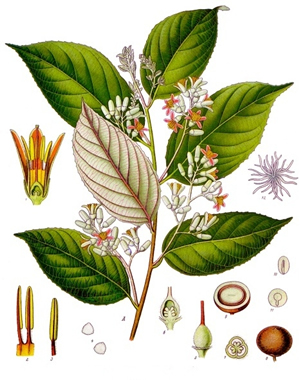Benzoin Styrax benzoin

Köhler's Medizinal-Pflanzen
- Common Names
- Benzoin Resin , Friar's balsam
- Botanical Name
- Styrax benzoin
- Family
- Styracaceae
Medicinal Uses & Benefits of Benzoin Resin
![]() How to Use|
Side Effects |
Plant & Garden|
Aromatherapy Oil |
How to Use|
Side Effects |
Plant & Garden|
Aromatherapy Oil |
- Medicinal Uses: * Aromatherapy
* Asthma
* Bronchitis
* Eczema
* Rheumatoid_arthritis
- Properties: * Antirheumatic * Aromatic * Calm * Circulation * Cordial * Deodorant/Perfumes * Diuretic * Expectorant * Meditation * Mood * Muscle Relaxant * Sedative * Stress * Vulnerary
- Parts Used: resin
How to Use: Benzoin
Benzoin has a long history of use in the East as an incense and in perfumes. Benzoin resin is a yang sedative, and has a pronounced effect on congestion, seemingly to melt away blockages. It is an expectorant, and warms and tones the heart and increases circulation. Use benzoin to ease congested breathing caused by asthma and allergies. 1
Skin Care: Use benzoin resin in external skin applications to heal cuts and sooth inflammation of rough cracked skin. Benzoin is indicated for use where there is redness, irritation, or itching, such as eczema. The dark, vanilla-like resin also acts as an anchoring base note for aromatherapy blends and as a fixative in perfumery.
Cold Conditions: Use Benzoin in massage blends and aromatherapy applications for all cold conditions of the respiratory system ( related to the lungs). Colds, influenza, coughs, and bronchitis all benefit from benzoin, as well as cold conditions of the joints such as gout and rheumatoid arthritis.1
Preparation Methods & Dosage :External uses only. Use a few drops of the resin in aroma lamps, or as a part of oil blends and skin creams.
Benzoin Remedies
Benzoin : Essential Oil Profile
Benzoin resin absolute is a thick, brownish-yellow oil with a sweet, balsamic odor with a hint of vanilla.
Benzoin Side Effects: Excessive amounts can cause drowsiness. Not for internal use.
Plant Description

The Benzoin tree is cultivated in Java, Sumatra, Cambodia, Vietnam, China and Thailand. The liquid benzoin is extracted from the bark of the tree by making an incision into the bark. The alcohol is then removed leaving a concentrated tincture known as a resin absolute.
Regional Traditions :Southeast Asia *











